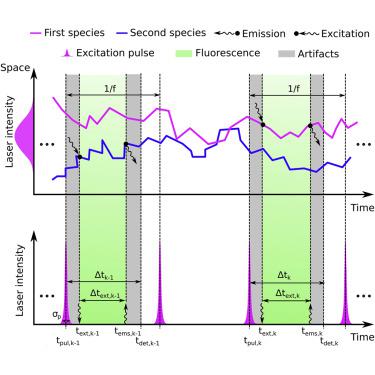Cell Reports Physical Science ( IF 7.9 ) Pub Date : 2020-10-14 , DOI: 10.1016/j.xcrp.2020.100234 Meysam Tavakoli 1 , Sina Jazani 2 , Ioannis Sgouralis 2 , Wooseok Heo 3 , Kunihiko Ishii 3, 4 , Tahei Tahara 3, 4 , Steve Pressé 2, 5, 6

|
Lifetimes of chemical species are typically estimated by either fitting time-correlated single-photon counting (TCSPC) histograms or phasor analysis from time-resolved photon arrivals. While both methods yield lifetimes in a computationally efficient manner, their performance is limited by choices made on the number of distinct chemical species contributing photons. However, the number of species is encoded in the photon arrival times collected for each illuminated spot and need not be set by hand a priori. Here, we propose a direct photon-by-photon analysis of data drawn from pulsed excitation experiments to infer, simultaneously and self-consistently, the number of species and their associated lifetimes from a few thousand photons. We do so by leveraging new mathematical tools within the Bayesian nonparametric. We benchmark our method for both simulated and experimental data for 1–4 species.
中文翻译:

使用贝叶斯非参数对时间分辨脉冲激发数据进行直接逐光子分析
化学物质的寿命通常通过拟合时间相关单光子计数(TCSPC)直方图或根据时间分辨光子到达进行相量分析来估计。虽然这两种方法都以计算有效的方式产生寿命,但它们的性能受到对贡献光子的不同化学物质数量的选择的限制。然而,物种的数量被编码在为每个照明点收集的光子到达时间中,并且不需要预先手动设置。在这里,我们提出对脉冲激发实验中获取的数据进行直接逐个光子分析,以同时且自洽地从几千个光子中推断出物种的数量及其相关的寿命。我们通过利用贝叶斯非参数中的新数学工具来做到这一点。我们针对 1-4 个物种的模拟和实验数据对我们的方法进行了基准测试。











































 京公网安备 11010802027423号
京公网安备 11010802027423号